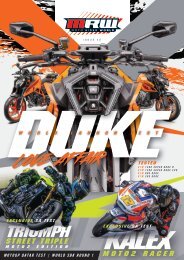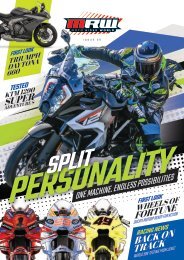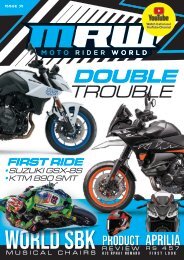Create successful ePaper yourself
Turn your PDF publications into a flip-book with our unique Google optimized e-Paper software.
Typically when one thinks of an Adventure bike<br />
the first one that comes to mind is the BMW<br />
GS. Even if you aren’t a biker chances are that<br />
you know of the GS. Each success story has a<br />
beginning though and for the GS, it all began<br />
in 1980, when BMW Motorrad presented the<br />
world’s first large dual-sport motorcycle in<br />
southern France with the R 80 G/S. Since then,<br />
the manufacturer has been setting the benchmark<br />
in this segment. And has constantly been writing<br />
success stories. Since then the BMW GS has<br />
been the benchmark or trendsetter if you will in<br />
the adventure segment. Even today the GS is<br />
still the most popular adventure bike around, the<br />
Godfather of adventure bikes in what has become<br />
the most popular segment of motorcycles<br />
worldwide.<br />
It was only in 2004 with the release of the<br />
1200GS that the GS craze started. The bike<br />
had increased capacity over the older 1150,<br />
as well as increased power and torque while<br />
weighing 30 kilos less. This resulted in an even<br />
more dynamic performance on all terrain and<br />
made the R1200GS the benchmark in adventure<br />
bikes. In 2005, the R 1200 GS Adventure<br />
followed for globetrotters. The R 1200 GS has<br />
been continually refined right down to the very<br />
last detail since its introduction: with the ESA<br />
(Electronic Suspension Adjustment) available<br />
since 2008, the rider is able to adjust the chassis<br />
and suspension to suit the road conditions while<br />
riding. The GS 1200 Enjoyed success from 2004<br />
to 2012 until it was heavily updated in 2013- enter<br />
the R1250GS.<br />
The completely redesigned opposed-twin engine<br />
heralded a new era for the R 1200 GS. For the<br />
first time, the BMW Motorrad engineers installed<br />
a water-cooled engine on the 1250. Moreover,<br />
the motorcycle boasted increased horsepower<br />
and enhanced performance, attributed to<br />
improved ride stability and precision, primarily<br />
due to the semi-active Dynamic ESA suspension.<br />
Additionally, riders now had the option to select<br />
from five different riding modes, rendering the<br />
GS1250 a comprehensive and dynamic choice for<br />
both enthusiasts and adventurers alike.<br />
Jumping ahead to 2024, BMW has undertaken<br />
the most significant overhaul of the GS since the<br />
original 1200GS debut. Expanded from 1254cc to<br />
precisely 1300cc, the GS now boasts unparalleled<br />
power and an extensive array of technological<br />
advancements. As the first production motorcycle<br />
to introduce Front Collision Warning (FCW), along<br />
with radar-adaptive cruise control and blind spot<br />
detection, the GS firmly reclaims its position at the<br />
forefront of technological innovation. Wrapped<br />
in a fresh chassis, revamped suspension, and<br />
redesigned ergonomics, the new GS makes<br />
its predecessor, the outgoing R1250GS, feel<br />
cumbersome and outdated. Although the<br />
test model lacked radar cruise control, the<br />
functionality remains consistent across models,<br />
and BMW’s implementation is expected to be<br />
equally impressive.<br />
The 1300 exhibits significant slimming across<br />
various aspects, evident from the redesigned front
















